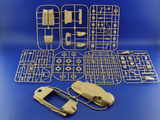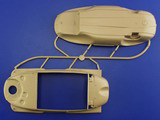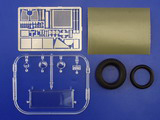| |
Eduard Schwimmwagen, 1/16 scale
(6106)
by Frank V. De Sisto
Contains: 177 styrene parts (including five clear), 38 photo-etched
parts, 10 vinyl parts, one sheet of masking material, two sets of water-slide
decals, 14 pages of instructions in 11 steps and one double-sided full-color
painting guide. Price: $99.95 USD.

This is Eduard’s first venture into the field of large-scale military
vehicle kits, and although not “perfect”, this kit has a great
deal of potential.
To begin with, the upper and lower hull sections capture the hydrodynamic
contours of this sleek, frog-like amphibian quite well. To the upper forward
hull is added such detail parts as the fuel filler caps, bumper, head
lights (with clear lenses), horn and mirror; spare tire holder, one-piece
clear windshield (with separate wiper blade and motor, mounts and wing-nuts),
and machine gun mount. The three-part Notek black-out lamp is especially
noteworthy as is complete with full underside detail. A nice shovel and
an oar is mounted on the upper hull side, along with a rail that represents
what I suppose is a sort of hand-hold/mooring aid (on each side). The
rear upper hull receives the exhaust pipes and shield, along with the
“hook” that is used to manually lift the propeller shroud
back up into its storage position. There is a three-part assembly depicting
the folded canvas roof and frames.

The crew compartment has a one-piece floor board insert with restrained
wood grain where applicable. There are various bulkheads and stiffeners,
forward and aft, as well as the pair of fuel tanks (with filler pipes)
that are seen underneath the forward upper hull. The steering wheel and
instrument panel are well detailed, with decals included for the dial
face and the gear shift instructions placard. The various levers and pedals
are also supplied. The front and rear seats are nicely done, with there
being an option to show the lower parts of the front seats folded upwards.
These also have separate wing nuts. There is also some tools included,
including what appears to be a jack and lug wrench.
The lower hull has a very nicely detailed front steering/ suspension
system consisting of nearly 20 parts, many of which are covered by the
separate under-belly plate. The wheels are not steerable, which, in this
scale, is disappointing. The rear suspension is also nicely done. The
wheel hubs are very nicely represented, while the two-part split rims
are mounted onto the hub’s studs with separate lug nuts. The vinyl/rubber
tires are of the narrow style and include a separate inner “O”-ring.
The tread detail is excellent and there are no pesky seams to deal with.
The propeller and shroud, as well as its mount are all nicely represented
and when complete, can be moved into the working or stored position. The
underbelly detail includes drain plugs and access plate details. There
are also two small parts (one for each side of the lower hull), which
represent the drains for the hull. The engine access hatch is molded in
place on the upper hull, which causes the seam line to disappear in one
place. The modeler will need to complete the seam with the scribing method
of his choice.

The photo-etch parts are brass, with nickel plating. They include parts
for the two intake screens on the hull top, as well as the larger intake
screen seen behind the two rear crew seats. Other etch parts compose the
front and rear license plates, the various flags and command plates used
with one of the markings options, clips that hold the windshield in the
“down” position, clamps for the oar and shovel, other odd
details, and even an ignition key.
Fit of the upper and lower hull parts is good, while the fit of the bulkheads
and tub for the inside of the crew compartment is fair. Not to worry;
some careful clean-up and a bit of filler will fix that. Other items exhibit
good fit such as the lower front plate that covers the suspension, the
wheel rims and hubs, and the suspension parts. So far, so good.
On the debit side, the potential for detail in a kit of this size has
not been fully realized. This is especially noticeable underneath and
forward of the dash-board. The fuel tanks lack finesse and there is no
provision for several tubes, their mounts and a small tray, all of which
are readily visible. The upward angled parts of the floor pan are also
wood and lack hinge detail as well as a foot switch. The machine gun pintle
should continue into the hull and be anchored on the bottom, but this
is not given. Some minor details, such as the stamped “25L”
(denoting 25 liters) next to each fuel cap are not present, while curiously,
the etch parts do not include clips for the “hook” used to
manually pull the prop out of the water, or the straps that held the prop
in place, once it was stowed. No provision has been made for the tires’
air filler valves. I have already mentioned that the front wheels do not
steer, and I think Eduard should have molded the engine hatch as a separate
part, weather they included an engine (which is not really the issue as
I see it), or not.
The quality of the molding is good, and there are virtually no ejector
pin marks or sink marks. Regarding the latter, Eduard wisely molded certain
assemblies in more than one part, to avoid this pitfall. Overall, fit
is fair-to-good, with clean up being about normal for any plastic kit.
The clear parts are distortion free, although the head-lamp lenses do
not have the engraved lines for the Fresnel lens effect, something which
is seen on many recent 1/35th-scale kits. The instructions are very clear
and should be quite easy to follow. The provided mask material will allow
easy painting of the windshield and the head-lamp lenses, as well as some
other items. The windshield mask also provides a separate piece to depict
the area that the wiper blades would keep clean, always a nice touch on
this type of model.
The two sets of water-slide decals depict a vehicle from Panzer Regiment
3 of the 2. Panzer Division, presumably in Normandy during the summer
of 1944. The other depicts a vehicle of the 17. Armee in the Soviet Union.
The printing is outstanding with excellent registration, detail and color
saturation, especially on the “Kuban” shield and command pennants.
References confirm the basic accuracy of the markings for the 17. Armee
vehicle, but I could not find anything for the 2. Panzer Division. However,
the regimental crest is confirmed through various sources. If modeling
the 17. Armee vehicle, there should be a field-modified boarding step
on at least the passenger’s side, and also a vehicle production
serial number (166/2335?) on the rear end, just below the “Kuban”
shield. This latter marking can also be seen on the front of the hull
side, near the shovel, as other photos confirm. The 166 stood for the
vehicle type, and the following numbers stood for the VW factory production
number. The markings are complimented by a full color painting guide showing
four views of each color scheme.
In the end, however, a nicely detailed model will result after careful
clean-up and assembly of what is included in the box. With some extra
effort on the part of the modeler, an outstanding, highly detailed replica
will be the result. With a bit more effort from Eduard, this kit would
have gotten a better recommendation and could be a “show stopper”
out of the box. But, one must remember that this is their first venture
into this scale. Eduard knows how to mold plastic, as anyone who has seen
some of their more recent 1/48th-scale aircraft can attest. So modelers
should expect better from them in the future.
Recommended.
Product images are used by permission of Eduard.
Eduard products are available at retail and mail order shops and directly
from the manufacturer at: www.eduard.cz.
Visit their web site for additional images of reviewed items.
|
|